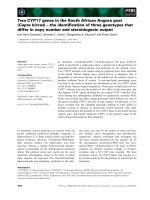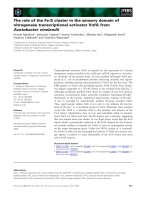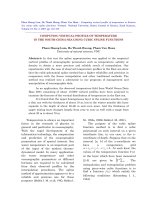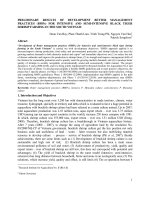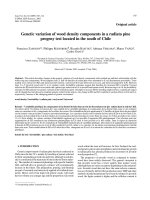0100 understanding china’s behaviour in the south china sea a defensive realist perspective
Bạn đang xem bản rút gọn của tài liệu. Xem và tải ngay bản đầy đủ của tài liệu tại đây (1.73 MB, 231 trang )
UnderstandingChi
na’sBehaviourin
theSouthChinaSea
ADefensiveRealistPerspective
KLAUSHEINRICHRADITIO
UnderstandingChina’sBehaviourintheSouth
ChinaSea
KlausHeinrichRaditio
UnderstandingChin
a’sBehaviourintheSo
uthChinaSea
ADefensiveRealistPerspective
KlausHeinrichRaditioU
niversityofSydneySydn
ey,NSW,Australia
ISBN978-981-13-1282-3
ISBN 978-981-13-1283-0( e B o o k )
/>LibraryofCongressControlNumber:2018950397
© TheEditor(s) (ifapplicable) andThe Author(s)2019
This work is subject to copyright. All rights are solely and exclusively licensed by
thePublisher,whetherthewholeorpartofthematerialisconcerned,specificallytherightsoftra
nslation, reprinting, reuse of illustrations, recitation, broadcasting, reproduction onmicrofilms or in any other
physical way, and transmission or information storage and retrieval,electronic
adaptation, computer software, or by similar or dissimilar methodology
nowknownorhereafterdeveloped.
The use of general descriptive names, registered names, trademarks, service marks, etc.
in thispublication does not imply, even in the absence of a specific statement, that
such names areexempt from the relevant protective laws and regulations and
therefore
free
for
general
use.Thepublisher,theauthorsandtheeditorsaresafetoassumethattheadviceandinformatio
ninthisbookarebelievedtobetrueandaccurateatthedateofpublication.Neitherthepub-lisher nor the authors or
the editors give a warranty, express or implied, with respect to thematerial
contained herein or for any errors or omissions that may have been made.
Thepublisher remains neutral with regard to jurisdictional claims in published maps
and institu-tionalaffiliations.
Coverillustration:©Pomogayev/
GettyImagesCoverDesignbyTomHowey
ThisPalgraveMacmillanimprintispublishedbytheregisteredcompanySpringerNatureSinga
porePteLtd.
Theregisteredcompanyaddressis:152BeachRoad,#2101/04GatewayEast,Singapore189721,Singapore
ForI n d o n e s i a
FOREWORD
Albert Einstein once said that “peace can only be achieved by
understanding”.Inaworldfullofsuspicionanddistrust,hiswordisveryrelevant.Our
knowledgeandunderstandingonothercountries, particularlytheemerging power like
China, are indeed of paramount importance. Forsome, the rise of
China
offers
plenty
of
opportunities,
and
success
awaitsthosewhocantakeadvantageofit.However,forothers,Chinaisst
illamystery.Its behaviour in the South China Sea, for instance, is
perplex-ing—andsometimesconsideredworrying.
Thisb ook—w h i ch offers thep ers p ecti veof d efe nsi v e real i st
—i sm ean t to deepen our understanding on China and its behaviour in the SouthChina
Sea. This fruitful research serves Indonesia’s diplomacy which consistently promotes inclusiveness and habit of dialogue. Indonesia’s
foreignpolicyaimsatalleviatinggreatpowersrivalry,maintainingpeace,sta
bility,andprosperity.
This research was successfully conducted and wins acclaim from
prominentscholarsininternationalrelations.IcongratulateKlausforpresentinghis
originalideaonChina’sbehaviourintheSouthChinaSea.Iamcon-fident that this
book
contributes
to
enhancing
our
understanding
onChinaandthecurrentstageofinternationalaffairs.
DirectorGeneralforAsiaPacificandAfrican Affairs of the Ministry of
Foreign Affairs, JakartaRepublicofIndonesia
DesraP e r c a y
a
vii
PREFaCE
I have conducted this research under the Australia Awards
Scholarship(AAS) scheme. I dedicate this research to my country
and hope thisresearch can help everyone, especially my fellow
Indonesians and Australianfriends,tounderstandChinabetter.
This research is conducted with generous support from my
principalsupervisorAssociateProfessorJingdongYuanandassociatesupervisorDrJustinHastings.I
am grateful also for support from the staff and col-leagues at the University of
Sydney’s Department of Government andInternationalRelations.
I would also like to thank the National Institute of South China
SeaStudies in Haikou, China, and the Centre for International Law, NationalUniversity of
Singapore,
where
I
conducted
my
fieldwork
in
NovemberandDecember2015.
MydeepestappreciationgoestotheForeignMinistryoftheRepublicof
Indonesia to which I belong, for giving me the opportunity to serve mycountry in the
scholarly field. I thank the Indonesian Consulate in Sydneyand all
the staff for their support and care while I have been
undertakingthis research, in particular Mr and Mrs Yayan Mulyana,
and Mr NovanIvanhoeSaleh.
I thank Dr Desra Percaya, the Director General for Asia-Pacific
andAfrican Affairs, for giving me the opportunities to develop my skill
indiplomacyandscholarlyfield.Iammostgratefulformycolleagues’sup-port,
particularly
Yvonne
Mewengkang,
Rifky
Akbar,
Raka
Pamungkas,GinaVirginianty,DiahSetyorini,andJunaedi.
ix
x
PREFACE
This research could not have been completed without moral
supportfrom my family, who created a positive atmosphere and helped me to be
abetterperson.
AdMaioremDeiGloriam!
Sydney,NSW,Australia
KlausHeinrichRaditioApril2018
CONTENTS
1 Introduction
1
1.1 Background
1
1.2 LiteratureReview
3
1.2.1 IstheNatureofChina’sSCSBehaviourChanging?
3
1.2.2 TheRationaleforChina’sChangingBehaviour
intheSCS
8
1.3 TheContributions
11
1.3.1 Contribution1:TheoreticalAnalysis
12
1.3.2 Contribution2:SystematicExplanation
12
1.4 ResearchQuestions
12
1.5 TheStructureoftheBook
14
2 TheoreticalFramework:SecurityDilemmaReconsider
ed
19
2.1 SecurityDilemma:TheConcept
19
2.2 TheRootoftheSecurityDilemma
22
2.3 SecurityDilemma:TheConstitutiveElements
24
2.4 TheActorswithintheSecurityDilemma
26
2.5 SecurityDilemma,Spiral,andDeterrence
29
2.6 AreThereVariantsofSecurityDilemmas?
32
2.7 SecurityDilemmaandConflictofInterest
34
2.8 TheContinuumoftheSecurityDilemma
37
2.9 CanaSecurityDilemmaBeMitigated?
41
xi
xii
CONTENTS
3 China’sClaimintheSouthChinaSea
49
3.1 China’sClaimintheSCS
49
3.2 China’sClaimandItsCompatibilitywithInternational
Law
52
3.2.1 LandCla ims
52
3.2.2 MaritimeClaims
57
3.3 TheUNCLOSTribunalRuling
60
3.3.1 TheArbitrationProcess
60
3.3.2 TheAwardoftheTribunal
61
3.4 Conclusion
63
4 China’sInterestsintheSouthChinaSea
69
4.1 China’sGrowingInterestsintheSCS
69
4.1.1 Resources
69
4.1.2 Security
71
4.1.3 Geopolitics
76
4.1.4 Taiwan
81
4.1.5 TheLegitimacyoftheChineseCommunistParty
83
4.2 Conclusion:InDefenceofChina’sInterestinSCS
86
5 China’sDefectionintheSouthChinaSea
95
5.1 ChinaasaDefensiveRealistState
95
5.2 TheSCSasaLitmusTestforChina’sDefensiveRealist
Behaviour
97
5.3 BriefHistoryofConflictintheSCS
100
5.4 DoesChina’sBehaviourintheSCSReflectthat
ofaDefensiveRealistState?
105
5.4.1 Is China Open to Non-military Solutions for the
SCSDispute?
105
5.4.2 DoesChinaShowSelf-restraintintheSCS?
107
5.4.3 DoesChinaAdoptReassurancePoliciesintheSCS?
110
5.5 China’sDefectionintheSCS
112
5.6 Conclusion
116
6 Security DilemmaBetween ChinaandOther
SouthChina
SeaClaimantStates
125
6.1 Introduction
6.2 TheElementsoftheSecurityDilemmaintheSCS
CONTENTS
6.3
6.4
6.5
6.6
ConflictofInterest
TheContinuumoftheSecurityDilemma
TheRationaleofChina’sDefectionintheSCS
HowCanChinaMitigatetheSecurityDilemma?
125
127
xiii
130
132
137
144
7 SecurityDilemmaBetweenChinavis-à-vistheUnited
StatesofAmericaintheSouthChinaSea
153
7.1 TheElementsofaSecurityDilemma
154
7.2 ConflictofInterests
160
7.2.1 MaritimeAccess
161
7.2.2 China’sRiseandtheUS’GlobalPosition
162
7.2.3 The Asymmetrical Interests Between Two Great
PowersintheAsianContext
165
7.3 TheContinuumofSecurityDilemma
166
7.4 HowFarCanChinaGo?
171
7.5 TheFutureofSino-USRivalryintheSCS
174
8 Conclusion
8.1 SummaryoftheResearchFindings
8.2 SignificanceforTheoryandPolicy
185
185
188
AppendixA:ChineseNotaVerbale(CML/17/2009)
totheUNSecretaryGeneral,7May2009
191
AppendixB:DiplomaticNotefromPhamVanDongtoZhou
Enlai(14September1958)
193
AppendixC:“Philippinesv.ChinaArbitrationCase:Summary
ofthePhilippinesSubmissionsandTribunalAwards”
197
Index
205
aBBREVIaTIONS
ADIZ
AirDefenceIdentificationZoneARF
ASEANRegionalForum
ASEAN
AssociationoftheSoutheastAsianNationsCCP
ChineseCommunistParty
CMS
ChinaMarineSurveillance
CNOOC
ChinaNationalOffshoreOilCooperation
DoC
DeclarationontheConductofPartiesintheSouthChinaSeaDRV
DemocraticRepublicofVietnam
ECS
EastChinaSea
EDCA
EnhancedDefenceCooperationAgreementEEZ
ExclusiveEconomicZone
FONOP
FreedomofNavigationOperationICC
InternationalCriminalCourt
ICJ
InternationalCourtofJustice
ITLOS
InternationalTribunalfortheLawoftheSeaJMSU
JointMarineSurveillanceUndertaking
LSG
LeadingSmallGroup
NATO
NorthAtlanticTreatyOrganizationOBOR
OneBeltOneRoad
PCA
PermanentCourtofArbitration PLA
People’s Liberation
ArmyPLAN
People’sLiberationArmyNavy PRC
People’s Republic of
ChinaRIMPAC Rim of the Pacific
ExerciseROC RepublicofChina
RVN
RepublicofVietnam
SCS
SouthChinaSea
xv
xvi
SRV
TAC
ABBREVIATIONS
SocialistRepublicofVietnam
ASEAN’sTreatyofAmityandCooperationTHAAD
TerminalHighAltitudeAreaDefence
UNCLCS
UnitedNationsCommissio no nt heLimi tsof theCo ntinent alShelf UNCLOS
UnitedNationsConventionontheLawoftheSea
LISTOFFIGURES
Fig.2.1
Fig.2.2
Fig.3.1
Fig.4.1
Thecontinuumofthesecuritydilemmaprocess(modifiedfrom
Tang,ATheoryofSecurityStrategiesforOurTime:Defensive
Realism,2010,p.65)
Kydd’s( 2 0 0 5 ) s p i r a l e q u i l i b r i u m
ThePa rac elI slands —depic te dbyM.G linoga
ThefirstandsecondislandchainsasdepictedbyA.B.Maramis
38
41
53
79
xvii
LISTOF T aBLES
Table 1.1
Table 2.1
Table 2.2
Table 5.1
Table 6.1
Table 7.1
Table 7.2
TheeventsthatsignifyChina’schangingbehaviour
Offensiveanddefensiverealiststatesinbrief
CountrieswithwhichChinahasasecuritydilemma
China’sactionsintheSCSandtheirsignificance
SourceoftheactivationofthesecuritydilemmaintheSCS
Thedifferencesbetween thetwosecuritydilemmas
Sourcesoftheactivationofthesecuritydilemmabetwee
n
ChinaandtheUS
4
29
36
116
134
167
168
xix
CHAPTER1
Introduction
1.1
BaCKGROUND
ThedisputeovertheSouthChinaSea(SCS)isoneofthehottestterritorialand
jurisdictional disputes in modern history. This resources-rich area
isclaimedbyChinaandfourothercountriesintheSoutheastAsianregio
n(Vietnam,thePhilippines,Malaysia,andBrunei),andbyTaiwan.Therehave been numerous
incidents in the SCS since the mid-1970s. In most ofthe high-profile
incidents—such as the 1974 Paracel Islands incidents, the1988
Johnson Reef incidents, the 1995 Mischief Reef incidents, and
the2012 Scarborough Shoal incidents—they have all involved China vis-à-vis other claimant
states.
Neither
the
incidents
among
nonChinaclaimantstatesthemselvesreceivehighprofilecoveragenoraretheyconsideredsig-nificant. China’s behaviour
has been at the centre of gravity with regard tostabilityin the
region. This might be because China is the latecomer
inestablishingapresenceintheSCS,especiallyintheSpratlys,regardlessofthe
fact that its claim dates back to a time before the founding of
thePeople’sRepublicofChinain1949.Thisresearch’sprimaryinterestis
toanalyse the nature of China’s SCS behaviour, itsrationale, and
developmentthathasledtoitsdefectionintheearlypartofthetwentyfirstcentury.
Priortotherecenttension,China’sbehaviourintheSoutheastAsianregio
nwasdescribedasrelativelyselfrestrained,accommodating,andreassuring.RalfEmmersdescribesthisperiodasone
ofde-escalationwhich lasted from the aftermath of the 1995 Mischief
Reef incident tobetween2007and2009. 1D u r i n g thisperiodofdeescalation,however,
©TheAuthor(s) 2019
K.H.Raditio,UnderstandingChina’sBehaviourintheSouthC
hinaSea, />
1
2
K. H. RADITIO
the situation in the SCS was not completely free of conflict.
Some skir-mishes between maritime law enforcement ships and
fishing boats fromChina and other claimants did take place, but
overall, the disputes werelow profile and no dramatic tension
occurred.2Until the late 1990s, theSCS tension was reduced, and the parties
concerned seemed content tokeepthestatusquo.3China itself became more open
to discussing the SCSissue in the context of ASEAN. 4The friction
among
the
claimant
stateswasreducedintheearly2000sbecauseofChina’sadoptionofareassur
-ance policy towards its ASEAN counterparts—stressing the peacefulnature of its
ascent.5China realised that without regional stability, devel-opment
and modernisation of the country would be hard to attain.
Thisreassurance policy towards ASEAN was adopted as the good
neighbour(mulinwaijiaowendingzhoubian)guidelinegainedpromin
enceinChineseforeignpolicy.6
ThisconducivesituationcontributedtothesigningoftheDeclarationon
the Conduct of Parties in the South China Sea (DoC) in November2002. The following
year, China signed the Treaty of Amity andCooperation (TAC) in
Southeast Asia, which prevents the signatoriesfrom using a
military approach in dealing with disputes in the region. Inthe
following years, these two agreements were effective in restraining
theclaimant states from making any provocative moves. In March 2005,China, the
Philippines, and Vietnam signed an agreement, the JointMarine
Seismic Undertaking (JMSU), which was applauded as a breakthrough in the dispute. 7In brief, the SCS experienced a period of tension de-escalation
in the mid-1990s until between 2007 and 2009 due
toChina’sreassurancepolicytowardsASEANcountries.
However,withtherecentconditionsintheSCS,itiseasytoconsiderthat
such a situation no longer applies due to a series of events such asChina’s stand-off with the
Philippines
in
the
2012
Scarborough
Shoalincident,ChinaVietnamtensioninthe2014HSYOilRigincident,andChina’smassivereclamation
in
the
SCS,
which
all
reflect
the
heightenedtension.IntheaftermathoftheScarboroughShoalincident,th
ePhilippines initiated a United Nations Convention on the Law of the
Sea(UNCLOS)TribunalinJanuary2013,whichwasunofficiallysupported
by Vietnam and Malaysia; the other claimant state, Brunei, seems to keepalowprofileattitudetowardsthedisputes.8
In addition to the dispute between claimant states, the US plays a
sig-nificant role in the SCS. It has officially been involved in the SCS
since
thethenUSSecretaryofStateHillaryClintonaffirmedthattheUShasan
INTRODUCTION
3
interestinmaintainingfreedomofnavigationintheSCSintheASEANRegio
nalForum(ARF)inHanoi,July2010 9—
whichseriouslyirritatesBeijing.TheUSpivottoAsiain2011–
2012alsocontributestotensionbetweenChinaandtheUSintheSCS.TheU
Shasalsoincreaseditsassis-tancetothePhilippinemilitaryintheframeworkoftheEnhanced
DefenceCooperationAgreement(EDCA)in2014.On5February2014,the
USDepartmentofStateissuedanofficialstatementdismissingChina’sni
nedashlineclaimtotheSCS,callingit“inconsistentwithinternationallaw”.10Theabo
ve-mentionedcaseshavecontributedtore-escalationoftension in the SCS. In view of China’s status as the rising power in the
region,thisresearchisinterestedinwhetherth enatureofChina’sb
ehaviourin theSCSischanging,fromreassurance andselfrestraintin theperiodof
de-escalationtotheopposite.
This research attempts to uncover the nature, rationale, and
develop-ment of China’s recent behaviour in the SCS from the
perspective ofdefensive realist theory. Regarding policy,this
research
is
significantbecauseasaparamountpowerintheregion,China’sbeh
aviourwillhaveagreatimpactonregionalorderandstability.China’sb
ehaviourintheSCS is a “litmus test” for the whole of its foreign policy. 11This means
thatChina’s behaviour in the SCS will determine how it pursues its
nationalinterestexternally,inboththepresentandthefuture.
1.2
LITERaTURER EVIEW
1.2.1 IstheNatureofChina’sSCSBehaviourChanging?
MostoftheliteraturedoesnotdiscussmuchaboutthenatureofChina’sbehavi
our in the SCS. Studies indicate the events that signify China’schanging behaviour in
the SCS. They differ in presenting the timing of thebehavioural shift,
ranging
from
as
early
as
2007
up
to
2012.
Table1.1summarisesthevariousviewsonthetimingandeventsthatsignifyChi
na’schangingbehaviourintheSCS.
Some of the events mentioned above still need factual
clarification,
forinstance,whetherChinahasbeguntoseetheSCSasitscoreinterest.IfChi
na has definitively asserted the SCS as a core interest alongside withTaiwan, Tibet, and
Xinjiang, this can also be considered as well as thechanging of
China’s stance on the SCS issue. The confusion of
whetherChinahaselevatedtheissuetoitscoreinterestlistbeganwhent
heUSmediareportedthemeetinginBeijingin March 2010withs
eniorUS
4
K. H. RADITIO
Table1.1T h e eventsthatsignifyChina’schangingbehaviour
Authors
2007
CarlyleA.Thayer 12
TranTruongThuy13
PeterDutton14
BonnieGlaser15
CliveSchofield&Ian
Storey16
TridibChakrabor ti 17
2009/2010
M.TaylorFravel18
Events
•C h i n a ’ s intimidationtowardsUSenergycompaniestoend
jointcooperationwithVietnamintheSCS
• China’s unilateralfishingban intheSCS
• China’s protest against a claim for extended
continentalshelvesandrenewalofitsclaim,whichcovers80%
oftheSCS
•C h i n a ’ s intimidationtowardsUSenergycompaniestoend
jointcooperationwithVietnamintheSCS
• TheestablishmentofthecityofSanshaforadministerin
gtheParacelandSpratlyIslandsinDecember2007
•C h i n a ’ s intimidationtowardsUSenergycompaniestoend
jointcooperationwithVietnamintheSCS
• China’s assertive behaviour towards the SCS
claimants in2007,andtowardstheUSin2009
•C h i n a ’ s intimidationtowardsUSenergycompaniestoend
jointcooperationwithVietnamintheSCS
• AnincidentinvolvedChinesenavalpatrolanda
Vietnamesefishingboat,killingonefisherman
• TheestablishmentofthecityofSanshaforadministerin
gtheParacelandSpratlyIslandsinDecember2007
• China’sintimidation towardsUSenergy companiest
oendjointcooperationwithVietnamintheSCS
•C h i n a ’ s intimidationtowardsUSenergycompaniestoend
jointcooperationwithVietnamintheSCS
• AnincidentinvolvedChinesenavalpatrolanda
Vietnamesefishingboat,killingonefisherman
• TheestablishmentofthecityofSanshaforadministerin
gtheParacelandSpratlyIslandsinDecember2007
•C h i n a ’ s submissionofthenine-dashlinemaptotheUN
CommissionontheLimitsoftheContinental Sh
elf(CLCS)onMay 2009
• Theexpansionoftheunilateralfishingban(2009)
• ThePLANexercisesintheSCSthroughout2010
Alastair IainJohnston19
MichaelYahuda 20
SarahRaine21
PekKoonHeng22
•T
•
•T
•C
•T h e increasingpresenceofChineseparamilitaryinthe
SCSinunprecedentednumbers
h e Impeccableincident
The increasingChinesenavalexercisesin theSCS
h e Impeccableincident
h i n a ’ s assertionoftheSCSasitscoreinterest
(continued)

